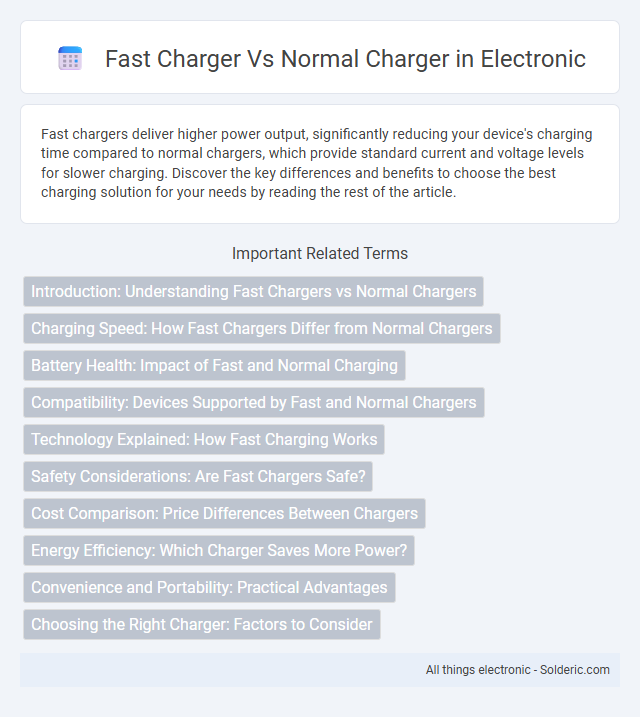Fast chargers deliver higher power output, significantly reducing your device's charging time compared to normal chargers, which provide standard current and voltage levels for slower charging. Discover the key differences and benefits to choose the best charging solution for your needs by reading the rest of the article.
Comparison Table
| Feature | Fast Charger | Normal Charger |
|---|---|---|
| Charging Speed | Up to 4x faster, typically 18W to 65W | Standard speed, usually 5W to 10W |
| Technology | Supports Quick Charge, Power Delivery (PD), or similar | Basic USB charging without advanced protocols |
| Compatibility | Requires compatible device and cable | Works with almost all USB devices |
| Heat Generation | More heat due to higher power transfer | Less heat generated |
| Cost | Higher price for charger and compatible cables | Usually cheaper and widely available |
| Battery Impact | Designed to minimize battery degradation | Gentle on battery but slower recharge |
Introduction: Understanding Fast Chargers vs Normal Chargers
Fast chargers use higher wattage and advanced technology to deliver power rapidly, significantly reducing battery recharge time compared to normal chargers, which operate at standard power levels. Normal chargers typically supply 5 to 10 watts, while fast chargers can provide 18 watts or more, enabling quicker energy transfer to compatible devices. Devices must support fast-charging protocols like Qualcomm Quick Charge or USB Power Delivery to maximize these benefits effectively.
Charging Speed: How Fast Chargers Differ from Normal Chargers
Fast chargers significantly reduce charging time by delivering higher power output, typically ranging from 18W to 120W or more, compared to normal chargers which usually provide 5W to 10W. This increased wattage enables fast chargers to charge compatible devices up to 50-80% in approximately 30 minutes, whereas normal chargers may take several hours for a full charge. The advanced technology in fast chargers optimizes current flow and battery health, ensuring efficient and rapid energy transfer.
Battery Health: Impact of Fast and Normal Charging
Fast chargers deliver higher voltage and current, which can cause increased heat generation and stress on your battery, potentially accelerating capacity degradation over time. Normal chargers provide a slower, steadier charge, minimizing thermal stress and preserving battery health by reducing the risk of swelling and capacity loss. Choosing normal charging whenever possible can extend the overall lifespan of your device's battery by maintaining optimal chemical balance and temperature.
Compatibility: Devices Supported by Fast and Normal Chargers
Fast chargers support a wide range of devices including smartphones, tablets, and laptops designed for quick power input, often utilizing USB Power Delivery (USB-PD) or Qualcomm Quick Charge standards. Normal chargers are compatible with nearly all electronic devices but deliver slower charging speeds due to lower wattage output. Compatibility depends on the device's ability to handle higher voltage and current levels provided by fast chargers, making it essential to verify device specifications before use.
Technology Explained: How Fast Charging Works
Fast charging technology increases the power output delivered to your device by using higher voltage or current, enabling significantly faster battery replenishment compared to normal chargers. This process involves advanced protocols like USB Power Delivery (PD) or Qualcomm Quick Charge, which communicate between the charger and device to optimize energy flow and prevent overheating. Understanding how fast chargers regulate voltage and manage battery temperature helps you choose the right charger for efficient and safe power delivery.
Safety Considerations: Are Fast Chargers Safe?
Fast chargers use higher voltage and current to reduce charging time, which can generate more heat and stress battery components, raising safety concerns if not properly managed. Modern fast chargers incorporate advanced safety features such as temperature control, overcurrent protection, and intelligent communication with devices to prevent overheating, short circuits, and battery damage. Reliable fast chargers from reputable brands meet stringent safety standards like UL, CE, and IEC, ensuring safe and efficient charging without compromising battery lifespan or user safety.
Cost Comparison: Price Differences Between Chargers
Fast chargers typically cost between $20 and $50 more than normal chargers, reflecting their advanced technology and quicker charging capabilities. Normal chargers usually range from $10 to $25, making them more affordable but slower in performance. Choosing the right charger depends on your budget and need for speed in powering your devices.
Energy Efficiency: Which Charger Saves More Power?
Fast chargers deliver higher power output by increasing voltage and current, which can lead to greater energy loss as heat during the charging process, reducing overall energy efficiency. Normal chargers use lower power levels and charge devices at a slower rate, resulting in less heat generation and typically higher energy efficiency for the same amount of battery capacity restored. Energy savings depend on usage patterns, but for daily charging, normal chargers generally consume less power due to reduced energy dissipation.
Convenience and Portability: Practical Advantages
Fast chargers significantly reduce charging time, offering greater convenience for busy lifestyles by allowing you to quickly power up your devices on the go. Normal chargers, while typically smaller and lighter, may lack the efficiency needed for rapid charging but often provide enhanced portability for minimalistic travel. Choosing between fast and normal chargers depends on your priority for speedy power replenishment versus compact, lightweight design.
Choosing the Right Charger: Factors to Consider
Choosing the right charger depends on factors such as device compatibility, charging speed, and battery health preservation. Fast chargers deliver higher wattage, enabling significantly quicker charging times but may generate more heat, potentially affecting long-term battery lifespan. Normal chargers provide a slower, steadier charge, which is gentler on battery cells and ideal for maintaining battery integrity over time.
Fast charger vs normal charger Infographic

 solderic.com
solderic.com